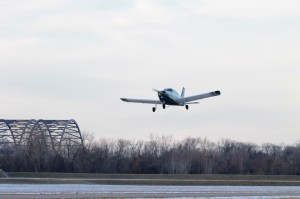 The dipstick is stuck. Someone must have flown the plane just a bit ago because the O Rings have tightened, and Jake can’t get the top off in order to check the fuel levels. Eager to finish pre-flight and wanting to be prepared before his instructor arrives, he searches for something to help him open the dipstick. “Usually it [pre-flight] is pretty easy,” senior Jake Ervin said. “You just follow the checklist. It’s only hard when things like this happen.”
The dipstick is stuck. Someone must have flown the plane just a bit ago because the O Rings have tightened, and Jake can’t get the top off in order to check the fuel levels. Eager to finish pre-flight and wanting to be prepared before his instructor arrives, he searches for something to help him open the dipstick. “Usually it [pre-flight] is pretty easy,” senior Jake Ervin said. “You just follow the checklist. It’s only hard when things like this happen.”
The love for flying started with Jake’s father, Dan Ervin, who works as an inspector for Boeing. Dan raised his sons around airplanes, taking them to air shows and open houses. Growing up around airplanes inspired both boys to look at careers in aeronautics. Jake’s brother, FHN graduate Ryan Ervin, plans to become an air traffic controller, and Jake wants to become a pilot for the Air Force. Both of Jake’s parents are proud to see him pursuing a career as a pilot.
“It’s just a dream that he’s always wanted to see Jake fly,” mother Ann Ervin said. “Flying has always been a dream for him. Mr. Ervin is very proud.”
Jake began taking lessons at the Creve Coeur Airport with the High Altitude Flying Company (HAFC) at the beginning of November. He plans to have his private pilot’s license by the end of the school year if the weather cooperates. Lately, though, the wind has been too strong for him to practice. Despite weather conditions, Jake still tries his best to get two lessons in per week. This can be difficult because Jake also works two jobs.
“It’s hard,” Jake said. “Sometimes work can be too much because it happens all at once. And I always seem to work when it’s not windy out”.
Currently, Jake’s parents pay for his lessons, which cost about $150 for an hour-long session. However, once Jake begins lessons for his commercial pilot’s license, he will have to pay the fees himself. Because the cost of lessons is so high, Jake must begin to save money now. In order to afford lessons, Jake works two jobs, one at Dierbergs and the other at the Boogey Hills Country Club.
“He works really hard,” friend and senior Tyler Ludwig said. “He has his two jobs and is saving money to be able to do this”.
In addition to balancing his jobs and schoolwork, Jake also studies for his lessons. For every hour that he is in the air, Jake reads and studies for about two to three hours. He gets his information from “Pilot’s Handbook of Aeronautical Knowledge,” a Federal Aviation Administration (FAA) handbook.
“Jake’s pretty determined, so I don’t have to worry about him taking these lessons and not using them,” Ann said.
“I’m just proud of him. He’s not out goofing off. He works two jobs, goes to high school and takes flying lessons.”
So far, Jake has had seven lessons and learned essential skills, like takeoffs and landings, stalling, and the instruments of the airplane. Just like learning to drive a car, the lessons Jake takes are hands on. According to HAFC’s mission statement, he will learn “all of the knowledge required” to pass the FAA written and practical exams. Before he can obtain a pilot’s license, he must complete 40 hours of flight time and pass the 60 question multiple choice exam as well as the practical exam.
“[I like] the challenge,” Jake said. “It’s not nearly as easy as driving a car. You have to keep track of so many things and work with people on the ground.”
At his lessons, Jake flies the plane with an instructor seated next to him. He follows the directions his instructor gives him and practices turns and stalls and other basics of flying. Jake enjoys being in the cockpit and learning from veteran pilots, but one of his favorite parts of being up in the clouds is the feeling of escape.
“I’d say flying is kind of an escape because I’m focused on something I love,” Jake said, “For that one to two hours in the sky, all I have to worry about is flying and not school or work.”
While Jake practices maneuvers, he flies over St. Charles and farmlands. He likes being in the air and practicing loops and rolls and barrel rolls. He’s also flown over the school, a view of which he made sure to get a picture to share with his friends.
“I’ve seen a lot of nice sunsets,” Jake said. “And not many students can say they’ve seen the school from the air.”
Jake believes that his persistence has helped him in learning to fly. When he doesn’t get something right away, he pushes himself until the task is accomplished. Jake’s determination and calm demeanor are what his family and friends believe attribute to his ability to be a great pilot.
“He’s quiet, and he really watches and observes the situation,” Ann said. “He doesn’t panic, and I think that’s a really good quality for a pilot.”
Jake’s calm demeanor is clear as he deals with getting the dipstick unstuck. He knows this is one small setback in a long series of challenges as he strives to become a better pilot and realizes that, with many things in life, the learning phase is never over.
“I like that you can always be a better pilot,” Jake said. “No one can perfect being a pilot.”






![Not Most Little Girls’ Dream [Personal Column]](https://FHNtoday.com/wp-content/uploads/2024/11/Copy-of-Mckenna-Hudson-Tales-of-a-child-delinquent-1200x800.png)







![The November Issue [Comic]](https://FHNtoday.com/wp-content/uploads/2024/12/Untitled_Artwork-2-856x1200.png)

